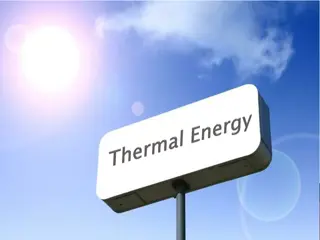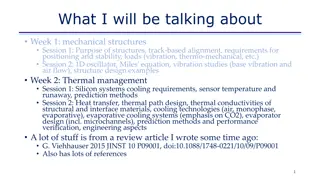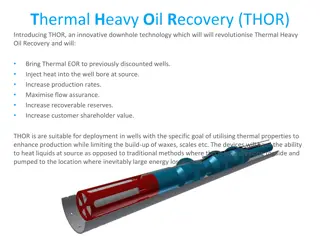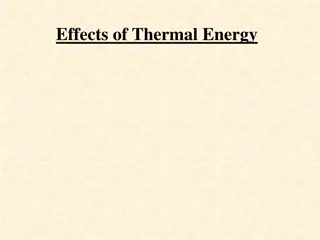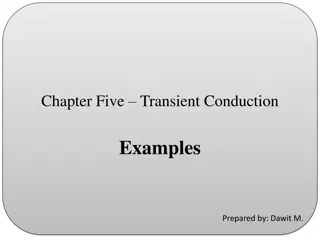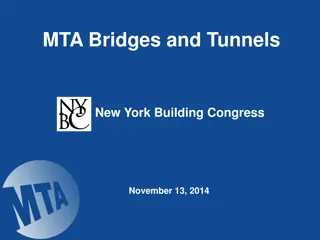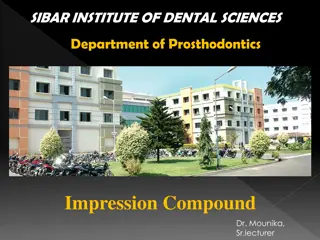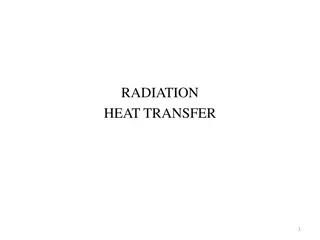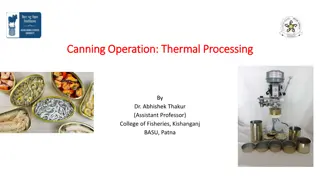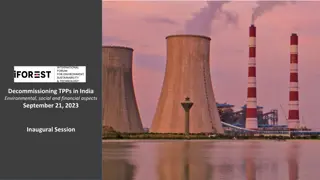Understanding Thermal Bridges in Building Design
The concept of thermal bridges in buildings is explored, focusing on heat transfer, evaluation assumptions, heterogeneous wall elements, deviations from one-dimensional flow, and thermal bridge zones. Practical implications for building design and energy efficiency are discussed.
Download Presentation

Please find below an Image/Link to download the presentation.
The content on the website is provided AS IS for your information and personal use only. It may not be sold, licensed, or shared on other websites without obtaining consent from the author. Download presentation by click this link. If you encounter any issues during the download, it is possible that the publisher has removed the file from their server.
E N D
Presentation Transcript
Dipartimento di Ingegneria Industriale e dellInformazione via Roma 29, 81031 Aversa, Italy MARUEEB project 561890-EPP-1-2015-1-IT-EPPKA2-CBHE-JP MASTER DEGREE IN INNOVATIVETECHNOLOGIES IN ENERGY EFFICIENT BUILDINGS FOR RUSSIAN & ARMENIAN UNIVERSITIES AND STAKEHOLDERS Thermal Bridges Speaker: Oronzio Manca
THERMAL BRIDGE: main concepts The heat transfer rate dispersed by a wall can be determined through the Fourier's law A s ( ) = Q T T 1 2 k
THERMAL BRIDGE: main concepts The evaluation can be carried out in a simple way under the following hypotheses: Steady state regime the material is isotropic and homogeneuos the height and width of the wall are much larger than its thickness the temperatures of the wall surfaces are uniform
THERMAL BRIDGE: main concepts These assumptions allow: Neglect the edge effects and, consequently Consider the thermal field and the heat flux vector as a one-dimensional
The perimetral walls of the buildings are not perfectly homogeneous Glazed windows or structural elements beams, pillars and slabs
These elements determine differences in the thermal behavior in wall areas where they are present Typically these elements values of have much higher than the ones of infill walls or masonry
Along the edges of the walls there are areas in which the hypothesis of one-dimensional flow is no longer satisfied This is due to the couplings with the other walls or slabs Both for the different thermal conductivity of the structures and for the particular geometry of the wall area
Geometric and structural configurations that produce deviations from the one-dimensional flow conditions THERMAL BRIDGE ZONES
T2 Te OUTDOOR T INDOOR Ti T1 x
CLASSIFICATION OF THERMAL BRIDGES Geometrical thermal bridge Thermal bridge of structure Mixed thermal bridge
CLASSIFICATION OF THERMAL BRIDGES Geometrical thermal bridge Portions of the considered domain where the deviation from the one-dimensional heat flux condition is due to the geometry of the structure
CLASSIFICATION OF THERMAL BRIDGES Geometrical thermal bridge Edge between two outer walls of the same structure
CLASSIFICATION OF THERMAL BRIDGES Geometrical thermal bridge T coupling between an outer wall and an inner wall of the same structure
CLASSIFICATION OF THERMAL BRIDGES Thermal bridge of structure Areas where the deviation from the one-dimensional heat flow condition is due solely to the presence in the wall of a building element having a different thermal conductivity
CLASSIFICATION OF THERMAL BRIDGES Thermal bridge of structure Junction between an outer wall and a casing (window)
CLASSIFICATION OF THERMAL BRIDGES Thermal bridge of structure Junction between an outer wall and a pillar inserted inside
CLASSIFICATION OF THERMAL BRIDGES Mixed thermal bridge Areas where there is an overlap of a geometrical and structure thermal bridges
CLASSIFICATION OF THERMAL BRIDGES Mixed thermal bridge T coupling between an outer wall and an inner wall of different structure or material
CLASSIFICATION OF THERMAL BRIDGES Mixed thermal bridge Edge between two outer walls of different structure or material
CLASSIFICATION OF THERMAL BRIDGES Mixed thermal bridge Corner pillar inserted in an external wall, different materials
THERMAL BRIDGE EFFECTS In the thermal bridge areas the heat flux transmitted through the structure is different from the value calculated in the one-dimensional heat flux assumption The existence of a two-dimensional or three- dimensional thermal field makes non-uniform the surface temperature of the walls
THERMAL BRIDGE EFFECTS Isotherms in a corner area between two walls of equal structure
THERMAL BRIDGE EFFECTS Isotherms in a joint between an outer wall and a casing
THERMAL BRIDGE EFFECTS When the outside temperature is much lower than the inside temperature and the relative humidity inside the room is very high The internal temperature can be lower than the dewpoint temperature Condensation of water vapor in the air and / or phenomena thermophoresis
THERMAL BRIDGES EFFECTS Thermophoresis Migration of the particles in the air to the surfaces caused by the temperature difference or temperature gradient. physical mechanism that contributes to aging of the products. The surfaces colder than the surrounding air continuously capture the dust creating damaging deposits to the preservation of the objects. In particular, condensation of the intrados of the floor in correspondence with the concrete rib.
THERMAL BRIDGES EFFECTS The heat flux Increases Thermal bridges determine a greater dispersion of energy from the inside to the outside
THERMAL BRIDGES EFFECTS Condensation determines problems caused by damp patches and it determines a decrease of the mechanical and physical characteristics of the wall materials
THERMAL BRIDGES EFFECTS The methodology to avoid the main problems due to a thermal bridge is : determine the temperature field in the thermal bridge area verify that the values of the internal surface temperatures are greater than the dewpoint (temperature), Tr in case this is not verified it should proceed to the thermal bridge correction with suitable constructive operations calculate the heat transfer rate dispersed by the thermal bridge whether it was correct or not
METHODS TO REDUCE THERMAL BRIDGES A thermal bridge can be eliminated or reduced by a suitable insulation It is reduced the dispersed heat flux It should be limited the effect of the temperature decrease of the on the inner surface of wall
METHODS TO REDUCE THERMAL BRIDGES It is reduced the dispersed heat flux by means of thermal insulation Internal thermal insulation External thermal insulation
METHODS TO REDUCE THERMAL BRIDGES If the thermal insulation is not perfectly continuous in correspondence with the thermal bridge The deviation from the one-dimensional flow condition is further accentuated
METHODS TO REDUCE THERMAL BRIDGES Thermal insulation inside the wall
METHODS TO REDUCE THERMAL BRIDGES It is not always possible to realize a continuous insulation due to architectural or constructional constraints There should be a suitable superposition of two layers of insulation in staggered arrangement
METHODS TO REDUCE THERMAL BRIDGES Two layers of insulation in staggered arrangement Internal thermal insulation Thermal insulation inside the wall
THERMAL BRIDGE HEAT TRANSFER RATE EVALUATION The study of heat transfer in the areas of thermal bridge is a heat conduction multidimensional problem in steady state regime
HEAT CONDUCTION EQUATION Hypotheses: Steady state regime Internal generation equal to zero Constant thermal conductivity (independent on temperature) 2 2 2 T T T + + = 0 2 2 2 x y z
2 2 2 T T T + + = 0 2 2 2 x y z For assigned material, the solution is a function of boundary conditions associated with the examined problem
For applications concerning the thermal bridge areas in the buildings, the boundary conditions are typically the following: heat flux continuity on interface surfaces between the examined domain and the external and internal environments conductive heat flux and temperature continuity at the interface between non-homogeneous layers one-dimensional heat flux imposed at a distance Lp. With Lpthe length of influence where for higher distances the thermal bridge effects are negligible
heat flux continuity on interface surfaces between the examined domain and the external and internal environments
conductive heat flux and temperature continuity at the interface between non-homogeneous layers
one-dimensional heat flux imposed at a distance Lp. With Lpthe length of influence where for higher distances the thermal bridge effects are negligible
2 2 2 T T T + + = 0 2 2 2 x y z The complexity of the geometry and the boundary conditions involves that the determination of the analytical solution present considerable difficulties
2 2 2 T T T + + = 0 2 2 2 x y z The solution of the problem is obtained by the aid of numerical methods
The commonly used numerical methods are those differences, volumes and finite elements The partial differential equation of conduction is approximated with a system of linear algebraic equations in the unknowns temperatures in a finite number of nodes, in which the domain was discretized
The resolution of this system allows to evaluate the temperature range of the thermal bridge in the zone, and then to verify whether or not condensation phenomena occur at the interface with the internal environment
Evaluated the thermal field, it is possible to evaluate the heat transfer rate dispersed by the thermal bridge as a function of the internal or external surface temperatures N ( ) l + = 1 j 1 Q T T dl i i j l j = 1 j
Total number of nodes on the inner surface of the thermal bridge Surface temperature of the j-th node N ( ) l + = 1 j 1 Q T T dl i i j l j = 1 j Air temperature of indoor enviroment Surface conductance, convective + radiative Coordinate of the j-th node
The evaluation heat transfer rate dispersed allows to calculate the linear transmission coefficient or the linear conductance coefficient The linear transmission coefficient or linear conductance coefficient, kL, is defined as the rate of thermal energy per unit of characteristic length of the thermal bridge, and per unit of temperature difference between the inside and the outside of the structure
Difference between the total heat transfer rate dispersed by the thermal bridge area and the heat transfer rate calculated in one- dimensional scheme for the same structure Q pt = k ( ) L L T T i e External air temperature
Q pt It is the increase in heat transfer rate compared to the one- dimensional flux condition for the thermal bridge area









